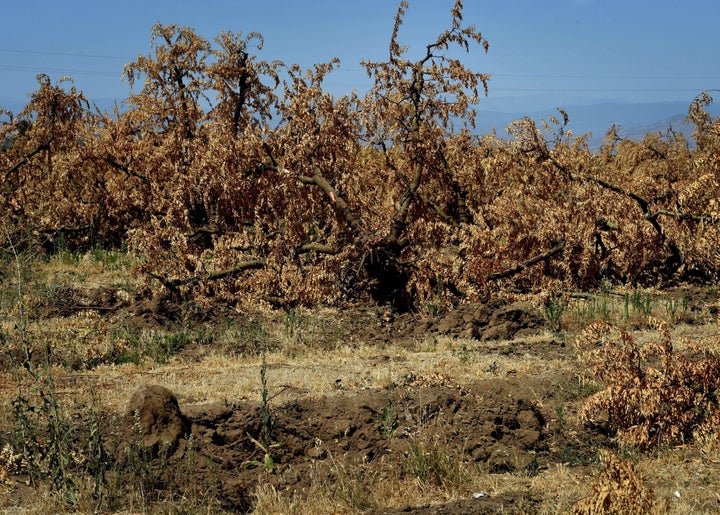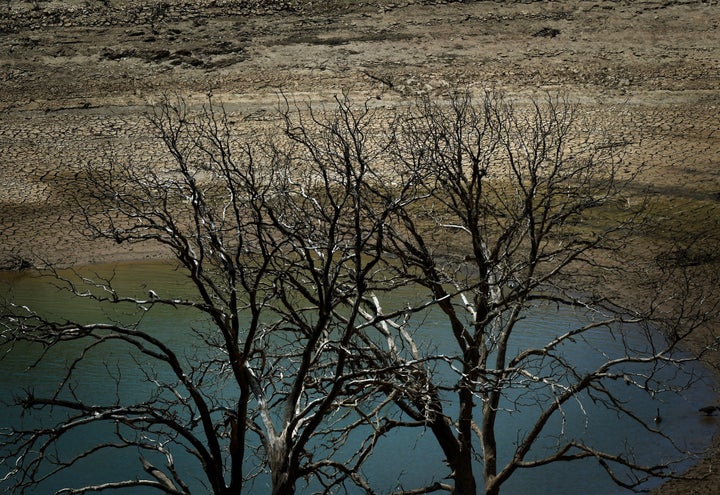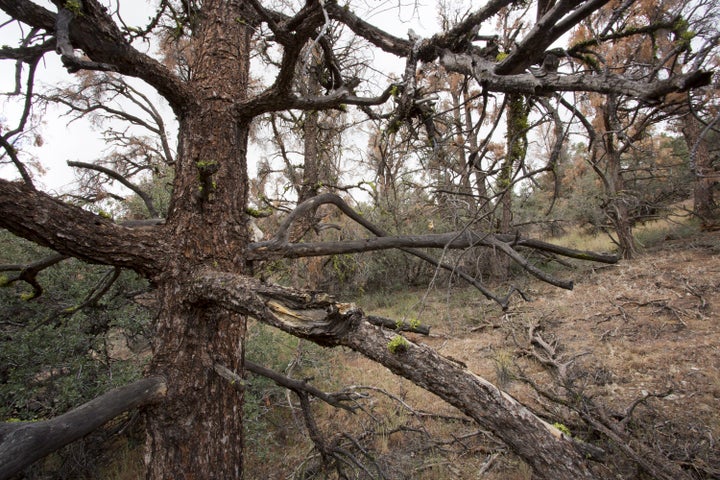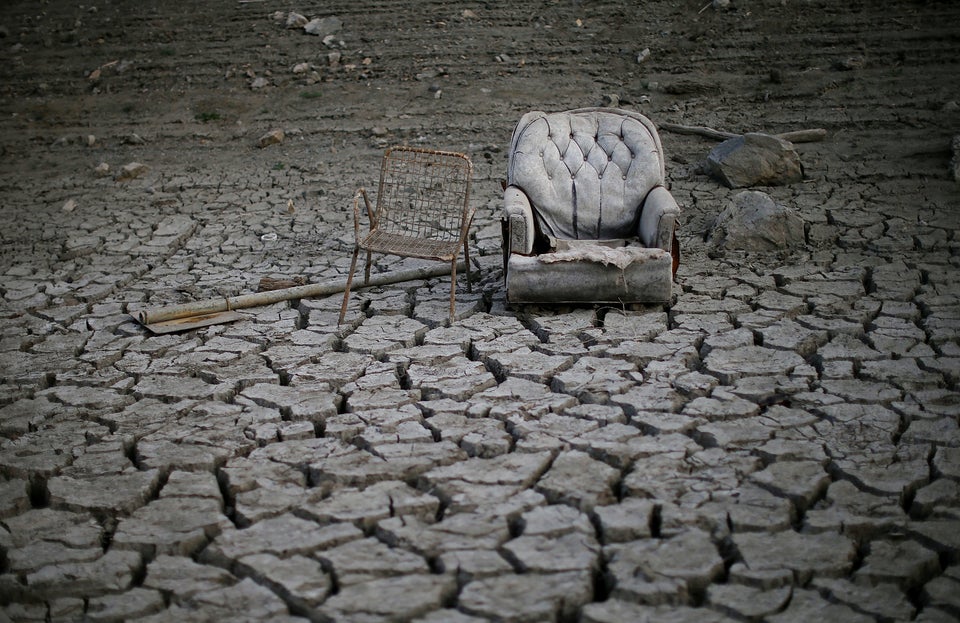
New research using high-tech tools to measure the moisture in trees found that 120 million trees across nearly every part of California are at risk of dying. Predictions that trends of higher temperatures and decreased precipitation will continue in the future could transform the state’s forests.
California is littered with dead trees. Four years of drought have pushed countless lone pines and forests alike to the brink of collapse, turning entire swathes of mountains from verdant to withering rust.
The numbers began rolling in early last summer with a U.S. Forest Service survey that tallied the death toll at 12 million. By September the agency revised its count to 21 million trees statewide. Soon the California Department of Forestry and Fire Protection (CAL FIRE), weighed in with 29 million confirmed dead trees.

Even those grim numbers, gathered through conventional on-the-ground and aerial estimates, were upended by a high-tech assessment done by scientists with the Carnegie Institution for Science. Four dry summers and four winters with a dramatically reduced snowpack have taken a toll throughout the Golden State, and will likely kill 58 million trees due to severe water loss, said Greg Asner, a Carnegie Institution biologist who published his results online on December 28 in Proceedings of the Natural Academy of Sciences. As many as 120 million trees statewide are in jeopardy from loss of water in their canopies, he said.
The higher temperatures and reduced precipitation that contributed to the die-off are widely predicted to continue, leaving California's forests poised for radical transformation.
"If drought conditions continue or reoccur, even with temporary reprieves such as El Niño, we predict substantial future forest change," Asner and his co-authors wrote.
They spent the summer doing aerial surveys throughout the state using remote sensing and modeling techniques that allowed them to look beyond what the naked eye can see to the motions of water molecules. Asner's twin turboprop Dornier 228 carried an onboard spectrometer and laser equipment that measured the water content inside a leaf or needle. The more water in the leaves, the less reflected light; the more reflected light, the drier the foliage.

Asner converted the 3-D images his equipment captured into topographic maps, which left little doubt about the hot spots. Virtually every corner of California has been affected by the drought, from the forests of the southern Sierra Nevada to the state's northwest. Asner called the mountains ringing Los Angeles "a tinderbox." The oak forests in the Sierra Foothills are "in big trouble," and Pinnacles is "not a happy place for a tree," he said in an interview with the Los Angeles Times. Even the forests northwest of Redding are "surprisingly compromised," Asner said.
His survey found the trees vulnerable due to extreme water loss represent 20 percent of the state's total.
Asner's assessments, combined with those from the state and federal agencies, contributed to Gov. Jerry Brown's October declaration of a state of emergency over dying trees. Brown called it “the worst epidemic of tree mortality” in the state’s modern history. He ordered state agencies to remove dead or dying trees from high-hazard areas and proposed expanding the number of days when tree waste can be burned.
That has triggered a variety of activities aimed at reducing the spread of insects infesting drought-weakened and standing dead trees, which are vulnerable to fire. This month CAL FIRE announced $1.7 million in grants to six central Sierra counties. Local projects will focus on removing dead and dying trees to reduce the wildfire threat around homes within Fresno, Kern, Madera, Mariposa, Tulare and Tuolumne counties, said Daniel Berlant, an agency spokesperson.

Partnerships are also mobilizing around the use of prescribed fire to improve forest health and minimize the effects of wildfires. The last several years have been a wake-up call urging more attention to putting fire back on the landscape in a more sophisticated way, said Jim Branham, executive officer for the Sierra Nevada Conservancy.
Other groups are analyzing the availability and placement of resources such as chippers and log-loaders. Their goal is to mobilize equipment in high-priority areas, moving it around much the way agencies relocate fire equipment, said Berlant.
Thinning forests and reducing accumulated biomass will improve the health of forests generally and make them more resilient to fire, said David Bischel, president of the California Forestry Association. "If we are not proactive, wildfire impacts will threaten water quality and supply at a time when we need it most," he said.
Along with a flurry of activity, Brown's dead-trees emergency declaration triggered alarm among some environmentalists, who questioned its exemption from the California Environmental Quality Act to boost efforts to remove dead or dying trees. Brian Nowicki of the Center for Biological Diversity challenged Brown's connection between dead trees and wildfire risk, emphasizing the need to maintain forests for wildlife habitat. Center officials also objected to the unrestricted waiver of air quality regulations.

A February 1 report issued by the U.S. Forest Service puts California's forest emergency in the longer-term perspective of a changing climate. The 300-page report cited worsening drought conditions in California and throughout the West that may be more than their ecosystems can handle: "There is growing consensus that extreme precipitation events will increase in frequency, and warmer temperatures will exacerbate the impacts of drought on forests and rangelands in the future."
Predictions like this foreshadow a series of cascading effects that reach far beyond dead and dying trees. We can, the federal scientists say, expect an increase in bark beetles. Insect infestations are currently the most important biotic cause of tree mortality, killing hundreds of millions of trees throughout the West as temperatures have warmed and precipitation has declined.
Dead trees are more vulnerable to fire than green trees. The West has already seen fire seasons that start sooner in the spring and last longer into the fall, adding a total of 78 days beyond the average fire season four decades ago. Scientists predict an increase of up to 125 percent in the areas that burn in California.
More indirectly, the drought-killed trees will affect the water produced in the nation's forests and the 60 million people who depend on it, the Forest Service report states. As water quantities slow with less precipitation, a concentration of nutrients and sediments reduces the water quality.
Most ominously, the combination of dead trees, insect infestation and fire on forest ecosystems will likely release carbon – perhaps more, in some places, than forests store. This could culminate in a feedback loop that adds to global carbon accumulations, said Matt Jolly, a Forest Service researcher and fire ecologist whose study was published in Nature Communications.
The widespread die-off of trees is disquieting wherever it occurs, but it evokes particular anxiety in California, host to the tallest, most massive and oldest trees on Earth. The response demands looking beyond the immediate emergency to the long-term impacts of climate change, said James Vose, a Forest Service research ecologist. Something "quite large-scale" is happening in California, North America and across the globe. “This is and will continue to be a major challenge for forest and rangeland managers – certainly if the current drought continues or gets worse,” he said.
This article originally appeared on Water Deeply. For weekly updates about the California drought, you can sign up to the Water Deeply email list.
Related on HuffPost:
